英语名词单复数变化规律及测习题
- 格式:doc
- 大小:37.50 KB
- 文档页数:7
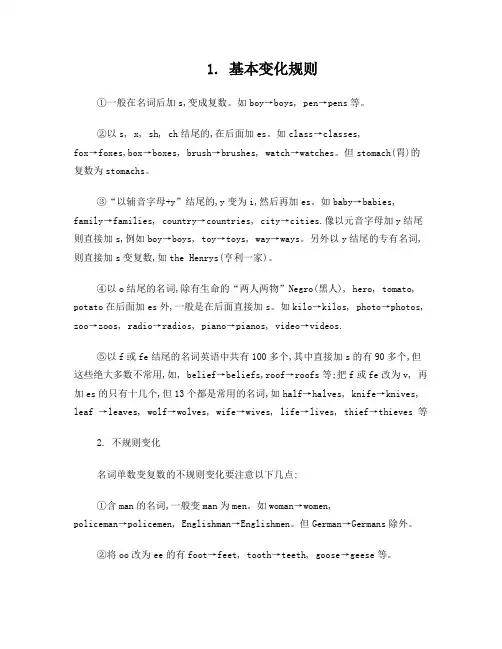
1. 基本变化规则①一般在名词后加s,变成复数。
如boy→boys, pen→pens等。
②以s, x, sh, ch结尾的,在后面加es。
如class→classes,fox→foxes,box→boxes, brush→brushes, watch→watches。
但stomach(胃)的复数为stomachs。
③“以辅音字母+y”结尾的,y变为i,然后再加es。
如baby→babies, family→families, country→countries, city→cities.像以元音字母加y结尾则直接加s,例如boy→boys, toy→toys, way→ways。
另外以y结尾的专有名词,则直接加s变复数,如the Henrys(亨利一家)。
④以o结尾的名词,除有生命的“两人两物”Negro(黑人), hero, tomato, potato在后面加es外,一般是在后面直接加s。
如kilo→kilos, photo→photos, zoo→zoos, radio→radios, piano→pianos, video→videos.⑤以f或fe结尾的名词英语中共有100多个,其中直接加s的有90多个,但这些绝大多数不常用,如, belief→beliefs,roof→roofs等;把f或fe改为v, 再加es的只有十几个,但13个都是常用的名词,如half→halves, knife→knives, leaf →leaves, wolf→wolves, wife→wives, life→lives, thief→thieves 等2. 不规则变化名词单数变复数的不规则变化要注意以下几点:①含man的名词,一般变man为men。
如woman→wom en,policeman→policemen, Englishman→Englishmen。
但German→Germans除外。
②将oo改为ee的有foot→feet, tooth→teeth, goose→geese等。
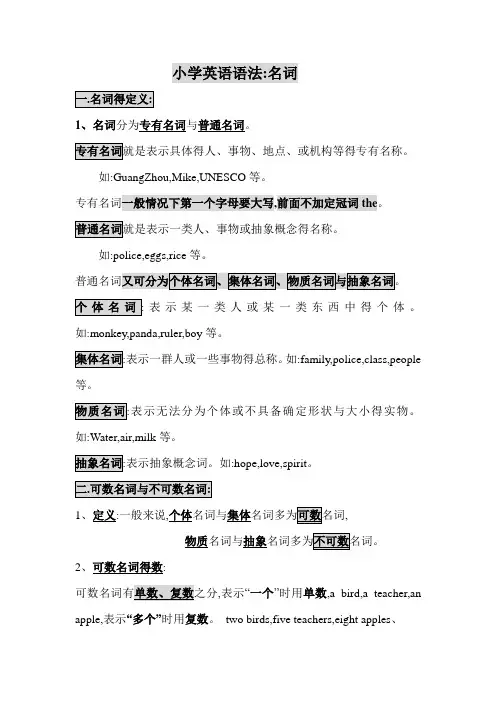
小学英语语法:名词1、名词分为专有名词与普通名词。
如:GuangZhou,Mike,UNESCO等。
专有名词一般情况下第一个字母要大写,前面不加定冠词the。
如:police,eggs,rice等。
表示某一类人或某一类东西中得个体。
如:monkey,panda,ruler,boy等。
表示一群人或一些事物得总称。
如:family,police,class,people 等。
表示无法分为个体或不具备确定形状与大小得实物。
如:Water,air,milk等。
表示抽象概念词。
如:hope,love,spirit。
1、定义:一般来说,个体名词与集体名词多为,物质名词与抽象名词多为2、可数名词得数:,表示“一个”时用单数,a bird,a teacher,an apple,表示“多个”时用复数。
two birds,five teachers,eight apples、3、可数名词复数得变化规则、A、一般情况下,在单数名词得后面加s构成。
如:gamegames,boyboys 等。
B、以s、x、sh、ch结尾得单数名词变复数,在词尾加es构成。
如:boxboxes,busbuses,peachpeaches,dishdishes。
C、以o结尾,表示有生命得事物得单数名词变复数加es;表示没有生命得事物得单数名词变复数加s。
如:potatopotatoes,tomatotomatoes,photophotos,pianopianos等。
D、以辅音字母加y结尾得单数名词变复数,将y改成i后再加es。
如:factoryfactories,storystories,familyfamilies。
E、以f或fe结尾得单数名词变复数,将f或fe改成v,然后再加es。
如:leafleaves,lifelives,knifeknives等。
F、名词单数变复数,除了有规则可循得变化之外,还有一部分得变化就是不规则得,我们将这部分名词得变化叫做不规则变化。
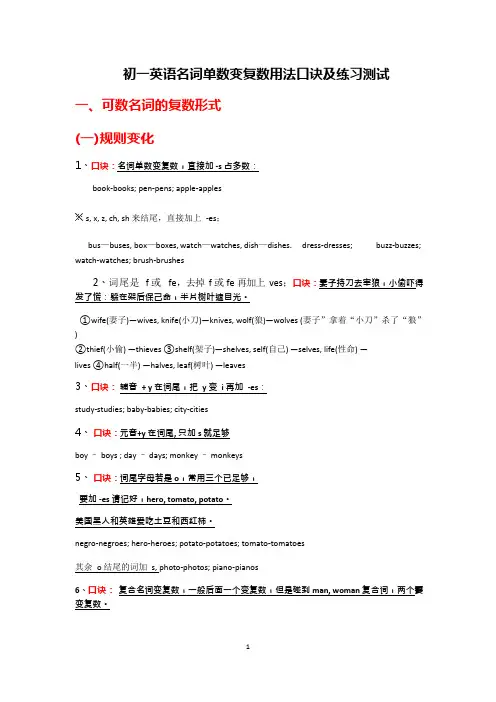
初一英语名词单数变复数用法口诀及练习测试一、可数名词的复数形式(一)规则变化1、口诀:名词单数变复数,直接加-s 占多数;book-books; pen-pens; apple-apples※s, x, z, ch, sh 来结尾,直接加上-es;bus—buses, box—boxes, watch—watches, dish—dishes. dress-dresses; buzz-buzzes; watch-watches; brush-brushes2、词尾是 f 或fe,去掉f 或fe 再加上ves;口诀:妻子持刀去宰狼,小偷吓得发了慌;躲在架后保己命,半片树叶遮目光。
①wife(妻子)—wives, knife(小刀)—knives, wolf(狼)—wolves (妻子”拿着“小刀”杀了“狼”)②thief(小偷) —thieves ③shelf(架子)—shelves, self(自己) —selves, life(性命) —lives ④half(一半) —halves, leaf(树叶) —leaves3、口诀:辅音+ y 在词尾,把y 变i 再加-es;study-studies; baby-babies; city-cities4、口诀:元音+y 在词尾, 只加s 就足够boy –boys ; day –days; monkey –monkeys5、口诀:词尾字母若是o,常用三个已足够,要加-es 请记好,hero, tomato, potato。
美国黑人和英雄爱吃土豆和西红柿。
negro-negroes; hero-heroes; potato-potatoes; tomato-tomatoes其余o 结尾的词加s, photo-photos; piano-pianos6、口诀:复合名词变复数,一般后面一个变复数,但是碰到man, woman 复合词,两个都要变复数。
如:grown-up—grown-ups (成年人)man docto—men doctors (男医生)(二) 不规则变化男人女人a 变e,鹅足牙oo 变ee;man-men; woman-women; goose-geese; foot-feet; tooth-teeth老鼠虱子也好记,ous 变ic;mouse-mice; louse-lice孩子加上ren,鱼鹿绵羊不用变child-children; fish; deer; sheepthis---these(这些) I --- we he/she--- they that -- those(那些)【说明】① man(男人)—men, woman(女人)—women, 含有man, woman 的合成词,其复数是把 a 变成e. 如:policewoman, postman, f isherman 等。
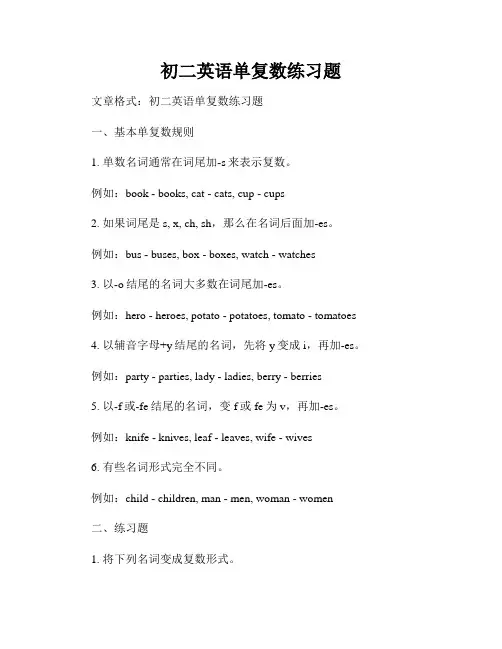
初二英语单复数练习题文章格式:初二英语单复数练习题一、基本单复数规则1. 单数名词通常在词尾加-s来表示复数。
例如:book - books, cat - cats, cup - cups2. 如果词尾是s, x, ch, sh,那么在名词后面加-es。
例如:bus - buses, box - boxes, watch - watches3. 以-o结尾的名词大多数在词尾加-es。
例如:hero - heroes, potato - potatoes, tomato - tomatoes 4. 以辅音字母+y结尾的名词,先将y变成i,再加-es。
例如:party - parties, lady - ladies, berry - berries5. 以-f或-fe结尾的名词,变f或fe为v,再加-es。
例如:knife - knives, leaf - leaves, wife - wives6. 有些名词形式完全不同。
例如:child - children, man - men, woman - women二、练习题1. 将下列名词变成复数形式。
答案:pens2) box答案:boxes3) tomato答案:tomatoes4) baby答案:babies5) bus答案:buses2. 选择正确的单词填空。
1) There are two _______ in the garden.a) dogb) dogsc) doges答案:b) dogs2) How many _______ are there on the table?a) bookesc) booxs答案:b) books3) The _______ is playing in the park.a) childb) childsc) children答案:c) children4) The _______ is taking a shower.a) womansb) womenc) woman答案:c) woman5) I have two _______.a) watchb) watchesc) watchs答案:b) watches3. 用括号内所给单词的正确形式填空。

三年级英语名词单数变复数规则和练习及答案内部编号:(YUUT-TBBY-MMUT-URRUY-UOOY-DBUYI-0128)三年级名词单数变复数规则1.一般情况下,直接加s如:apple-apples pig-pigs book-books2.以s、sh、ch、x结尾的名词,加es如:bus-buses(公车) class-classes(班级)fish-fishes(此时的fish当“鱼的种类”讲)watch-watches(手表) box-boxes(盒子) fox-foxes(狐狸)3.以元音字母+y结尾的名词,直接加s如:boy-boys(男孩) toy-toys(玩具)4.以辅音字母+y结尾的名词,去y改ies如:family-families(家庭) strawberry-strawberries(草莓)5.以f或fe结尾的名词,去f或fe改ves如:wife-wives knife-knives wolf-wolves(这三个词的记忆口诀---“妻子”拿着“小刀”杀了“狼”)6.以”o"结尾的名词:(1)有生命的,加es,如:potato-potatoes tomato-tomatoes hero-heroes(这三个词的记忆口诀---”英雄“爱吃”土豆“和”西红柿“)(2)无生命的,加s .如:photo-photos(照片) radio-radios(收音机)Piano—pianos(钢琴)7.将“oo”改为“ee"的名词如:tooth-teeth(牙) foot-feet(脚) goose-geese(鹅)8.单复同形的名词:(1)f ish-fish(此时fish当“同类鱼的很多条”讲)sheep-sheep(绵羊) paper-paper(纸)people-people(peoples表示“民族”)Chinese-Chinese(中国人) Japanese-Japanese(日本人)(2)不可数名词,如:water(水),rice(米饭),milk(牛奶),juice(果汁),bread(面包),tea(茶),orange(橙汁)9.不规则变化的名词:(1)m an-men,woman-women (记忆方法,“男人”变“女人”,“a”变“e”.延伸policeman-policemen policewoman-policem(2)c hild-children(孩子)(3)m ouse-mice(老鼠)(4)根据中文意思变化的名词,如:I-we (我-我们) you-you (你-你们)he/she/it-they (他/她/它-他们)this-these(这个-这些) that-those(那个-那些)am/is –are (是) has-have(有)注:apple tree-apple trees man teacher-men teachers以此类推课堂练习一.出下列各词的复数。
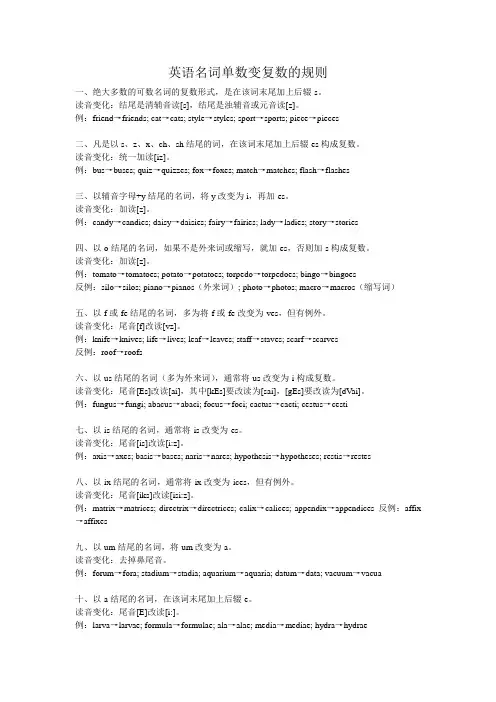
英语名词单数变复数的规则一、绝大多数的可数名词的复数形式,是在该词末尾加上后辍-s。
读音变化:结尾是清辅音读[s],结尾是浊辅音或元音读[z]。
例:friend→friends; cat→cats; style→styles; sport→sports; piece→pieces二、凡是以s、z、x、ch、sh结尾的词,在该词末尾加上后辍-es构成复数。
读音变化:统一加读[iz]。
例:bus→buses; quiz→quizzes; fox→foxes; match→matches; flash→flashes三、以辅音字母+y结尾的名词,将y改变为i,再加-es。
读音变化:加读[z]。
例:candy→candies; daisy→daisies; fairy→fairies; lady→ladies; story→stories四、以-o结尾的名词,如果不是外来词或缩写,就加-es,否则加-s构成复数。
读音变化:加读[z]。
例:tomato→tomatoes; potato→potatoes; torpedo→torpedoes; bingo→bingoes反例:silo→silos; piano→pianos(外来词); photo→photos; macro→macros(缩写词)五、以-f或-fe结尾的名词,多为将-f或-fe改变为-ves,但有例外。
读音变化:尾音[f]改读[vz]。
例:knife→knives; life→lives; leaf→leaves; staff→staves; scarf→scarves反例:roof→roofs六、以-us结尾的名词(多为外来词),通常将-us改变为-i构成复数。
读音变化:尾音[Es]改读[ai],其中[kEs]要改读为[sai],[gEs]要改读为[dVai]。
例:fungus→fungi; abacus→abaci; focus→foci; cactus→cacti; cestus→cesti七、以-is结尾的名词,通常将-is改变为-es。
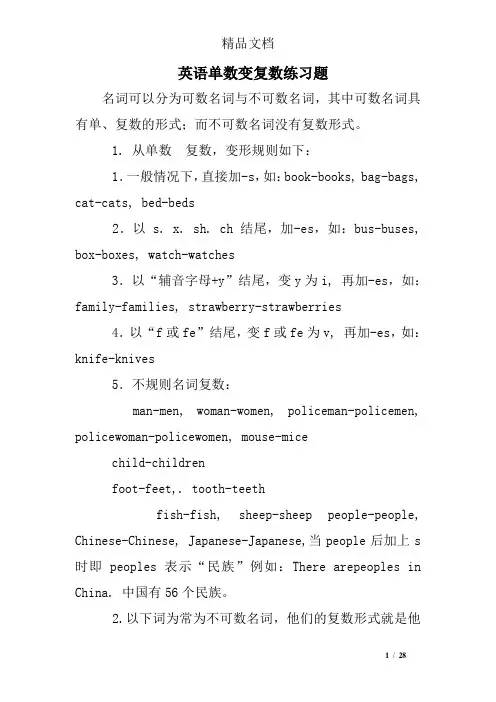
英语单数变复数练习题名词可以分为可数名词与不可数名词,其中可数名词具有单、复数的形式;而不可数名词没有复数形式。
1. 从单数复数,变形规则如下:1.一般情况下,直接加-s,如:book-books, bag-bags, cat-cats, bed-beds2.以s. x. sh. ch结尾,加-es,如:bus-buses, box-boxes, watch-watches3.以“辅音字母+y”结尾,变y为i, 再加-es,如:family-families, strawberry-strawberries4.以“f或fe”结尾,变f或fe为v, 再加-es,如:knife-knives5.不规则名词复数:man-men, woman-women, policeman-policemen, policewoman-policewomen, mouse-micechild-childrenfoot-feet,. tooth-teethfish-fish, sheep-sheep people-people, Chinese-Chinese, Japanese-Japanese,当people后加上s 时即peoples表示“民族”例如:There arepeoples in China. 中国有56个民族。
2.以下词为常为不可数名词,他们的复数形式就是他们本身。
Water milk tea rice orangejuicebread 练习题写出下列各词的复数I _________this ___________that___________watch _______child _______photo ________diary _________day________ foot________ book_______ dress ______________tooth_______ sheep ______box_______ strawberry _____________thief _______yo-yo ______ peach______ sandwich _______________man______ woman_______ paper_______ juice____________________water________ milk________ rice__________ tea_______________-注意be 动词遇到名词时的运用: 单数名词用is, 复数名词全用are.名词单复数讲解及练习名词单复数名词可以分为可数名词和不可数名词,不可数名词没有单复数,一律看作单数。
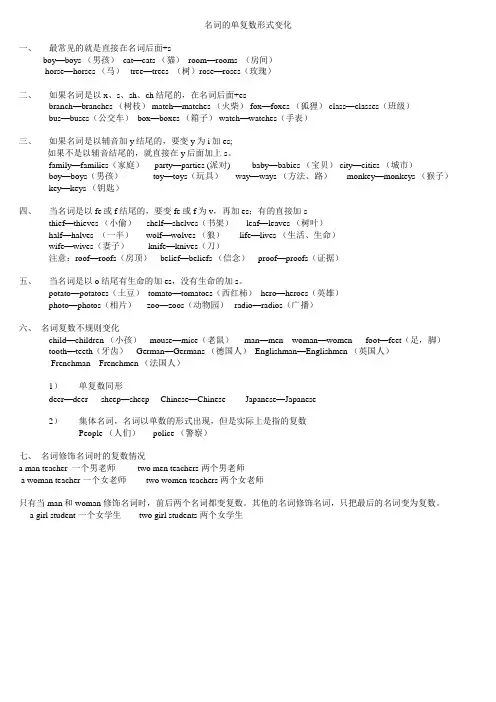
名词的单复数形式变化一、最常见的就是直接在名词后面+sboy—boys (男孩) cat—cats (猫) room—rooms (房间)horse—horses (马) tree—trees (树)rose—roses(玫瑰)二、如果名词是以x、s、sh、ch结尾的,在名词后面+esbranch—branches (树枝) match—matches (火柴) fox—foxes (狐狸) class—classes(班级)bus—buses(公交车) box—boxes (箱子) watch—watches(手表)三、如果名词是以辅音加y结尾的,要变y为i加es;如果不是以辅音结尾的,就直接在y后面加上s。
family—families(家庭) party—parties (派对) baby—babies (宝贝) city—cities (城市)boy—boys(男孩) toy—toys(玩具) way—ways (方法、路)monkey—monkeys (猴子) key—keys (钥匙)四、当名词是以fe或f结尾的,要变fe或f为v,再加es;有的直接加sthief—thieves (小偷)shelf—shelves(书架) leaf—leaves (树叶)half—halves (一半) wolf—wolves (狼) life—lives (生活、生命)wife—wives(妻子) knife—knives(刀)注意:roof—roofs(房顶)belief—beliefs (信念) proof—proofs(证据)五、当名词是以o结尾有生命的加es,没有生命的加s。
potato—potatoes(土豆) tomato—tomatoes(西红柿) hero—heroes(英雄)photo—photos(相片) zoo—zoos(动物园) radio—radios(广播)六、名词复数不规则变化child—children (小孩) mouse—mice(老鼠) man—men woman—women foot—feet(足,脚) tooth—teeth (牙齿)German—Germans (德国人)Englishman—Englishmen (英国人)Frenchman---Frenchmen (法国人)1)单复数同形deer—deer sheep—sheep Chinese—Chinese Japanese—Japanese2)集体名词,名词以单数的形式出现,但是实际上是指的复数People (人们) police (警察)七、名词修饰名词时的复数情况a man teacher 一个男老师 two men teachers 两个男老师a woman teacher 一个女老师 two women teachers 两个女老师只有当man和woman 修饰名词时,前后两个名词都变复数。
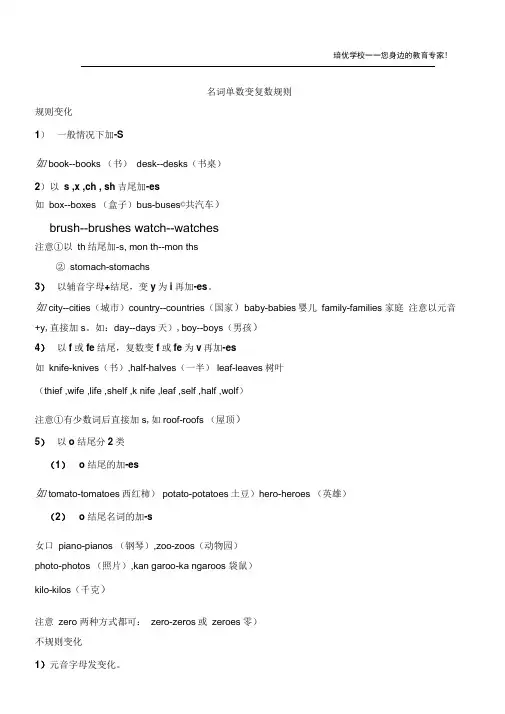
名词单数变复数规则规则变化1)一般情况下加-S如 book--books (书)desk--desks(书桌)2)以s ,x ,ch , sh吉尾加-es如box--boxes (盒子)bus-buses©共汽车)brush--brushes watch--watches注意①以th结尾加-s, mon th--mon ths② stomach-stomachs3)以辅音字母+结尾,变y为i再加-es。
如 city--cities(城市)country--countries(国家)baby-babies婴儿family-families 家庭注意以元音+y,直接加s。
如:day--days天),boy--boys(男孩)4)以f或fe结尾,复数变f或fe为v再加-es如knife-knives(书),half-halves(一半) leaf-leaves树叶(thief ,wife ,life ,shelf ,k nife ,leaf ,self ,half ,wolf)注意①有少数词后直接加s,如roof-roofs (屋顶)5)以o结尾分2类(1)o结尾的加-es如 tomato-tomatoes西红柿) potato-potatoes土豆)hero-heroes (英雄)(2)o结尾名词的加-s女口piano-pianos (钢琴),zoo-zoos(动物园)photo-photos (照片),kan garoo-ka ngaroos 袋鼠)kilo-kilos(千克)注意zero 两种方式都可:zero-zeros或zeroes零)不规则变化1)元音字母发变化。
如 man--men男人), woman--women(妇女)tooth--teeth(牙齿),foot--feet(脚)mouse-mice老鼠), policeman--policemen警察)policewoma n--policewome n(女警察)2)词尾发生变化。
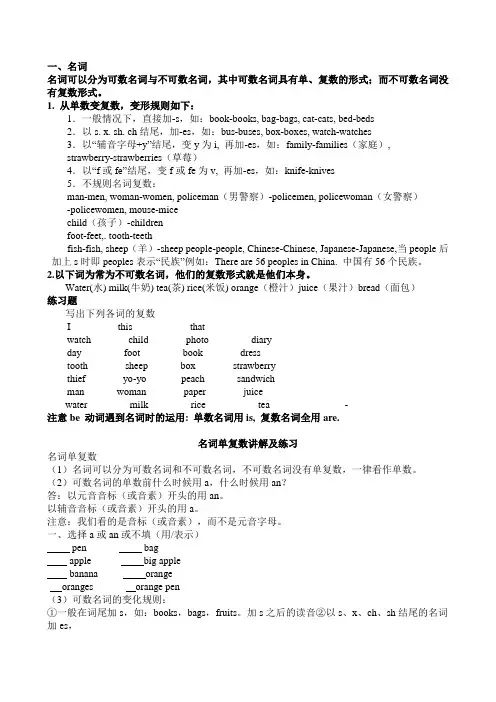
一、名词名词可以分为可数名词与不可数名词,其中可数名词具有单、复数的形式;而不可数名词没有复数形式。
1. 从单数变复数,变形规则如下:1.一般情况下,直接加-s,如:book-books, bag-bags, cat-cats, bed-beds2.以s. x. sh. ch结尾,加-es,如:bus-buses, box-boxes, watch-watches3.以“辅音字母+y”结尾,变y为i, 再加-es,如:family-families(家庭),strawberry-strawberries(草莓)4.以“f或fe”结尾,变f或fe为v, 再加-es,如:knife-knives5.不规则名词复数:man-men, woman-women, policeman(男警察)-policemen, policewoman(女警察)-policewomen, mouse-micechild(孩子)-childrenfoot-feet,. tooth-teethfish-fish, sheep(羊)-sheep people-people, Chinese-Chinese, Japanese-Japanese,当people后加上s时即peoples表示“民族”例如:There are 56 peoples in China. 中国有56个民族。
2.以下词为常为不可数名词,他们的复数形式就是他们本身。
Water(水) milk(牛奶) tea(茶) rice(米饭) orange(橙汁)juice(果汁)bread(面包)练习题写出下列各词的复数I _________this ___________that___________watch _______child _______photo ________diary _________day________ foot________ book_______ dress ______________tooth_______ sheep ______box_______ strawberry _____________thief _______yo-yo ______ peach______ sandwich _______________man______ woman_______ paper_______ juice____________________water________ milk________ rice__________ tea_______________-注意be 动词遇到名词时的运用: 单数名词用is, 复数名词全用are.名词单复数讲解及练习名词单复数(1)名词可以分为可数名词和不可数名词,不可数名词没有单复数,一律看作单数。
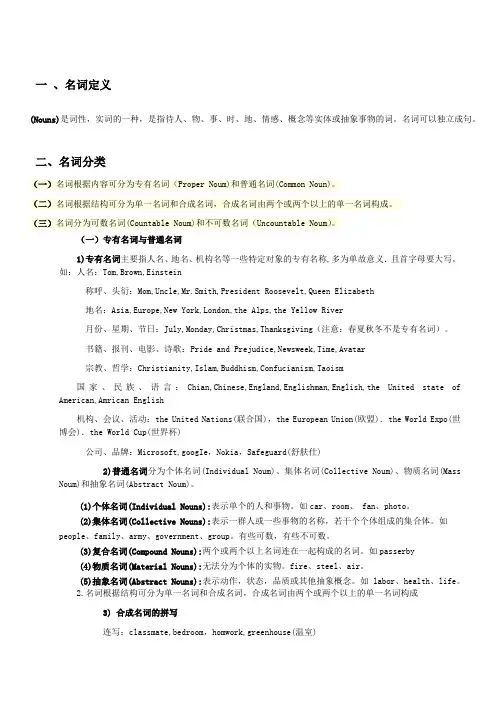
一、名词定义(Nouns)是词性,实词的一种,是指待人、物、事、时、地、情感、概念等实体或抽象事物的词。
名词可以独立成句。
二、名词分类(一)名词根据内容可分为专有名词(Proper Noum)和普通名词(Common Noun)。
(二)名词根据结构可分为单一名词和合成名词,合成名词由两个或两个以上的单一名词构成。
(三)名词分为可数名词(Countable Noum)和不可数名词(Uncountable Noum)。
(一)专有名词与普通名词1)专有名词主要指人名、地名、机构名等一些特定对象的专有名称,多为单故意义.且首字母要大写。
如:人名:Tom,Brown,Einstein称呼、头衍:Mom,Uncle,Mr.Smith,President Roosevelt,Queen Elizabeth地名:Asia,Europe,New York,London,the Alps,the Yellow River月份、星期、节日:July,Monday,Christmas,Thanksgiving(注意:春夏秋冬不是专有名词)。
书籍、报刊、电影、诗歌:Pride and Prejudice,Newsweek,Time,Avatar宗教、哲学:Christianity,Islam,Buddhism,Confucianism,Taoism国家、民族、语言:Chian,Chinese,England,Englishman,English,the United state of American,Amrican English机构、会议、活动:the United Nations(联合国),the European Union(欧盟).the World Expo(世博会).the World Cup(世界杯)公司、品牌:Microsoft,googIe,Nokia,Safeguard(舒肤仕)2)普通名词分为个体名词(Individual Noum)、集体名词(Collective Noum)、物质名词(MassNoum)和抽象名词(Abstract Noum)。
名词的复数知识点:英语中的可数名词有单数和复数之分,复数形式的变化规则如下:一、可数名词复数的规则变化。
1.一般情况下直接在名词词尾加“s”。
如: cat →cats, friend →friends。
2.以“s、x、ch、sh”结尾的可数名词,应该在词尾加“es”。
如: bus →buses, box →boxes, watch →watches, brush →brushes。
3.以“辅音字母+ y”结尾的可数名词,应该先变“y”为“i”再加“es”。
如:library →libraries, baby →babies。
4.以“o”结尾的可数名词,有生命的名词加“es”,无生命的名词加“s”。
如:tomato →tomatoes, photo →photos。
5.以“f”或“fe”结尾的可数名词,多数情况下应该变“f”或“fe”为“ves”。
如:knife →knives。
二、可数名词复数的不规则变化。
1.单复数同形。
如: sheep →sheep, deer →deer, Japanese →Japanese, Swiss →Swiss。
2.其他形式的不规则变化。
如:man →men, woman →women, child →children。
3.以 man 和 woman 修饰名词构成的合成词变复数时,两个词都要变化。
如: woman doctor →women doctors。
三、s 在名词词尾的读音规则。
1.在/p/、/t/、/k/、/f/等清辅音后读作/s/,如: cups, hats, cakes, roofs。
2.在/s/、/z/、/ ʃ /、/ tʃ /等音素后读作/ɪz/,如: glasses, faces, roses。
3.在其他情况下读作/z/,如:days, cities, knives。
4.th在词尾原本应该读作/θ/,加 s后则多数读作/ǒz/。
如: mouth→ mouths, path →paths;但是也有不变化的情况,如: month→months;ninth→ninths; youth →youths。
名词单复数变化及练习题名词的单复数名词 (Nouns)是词性的⼀种,也是实词的⼀种,是指待⼈、物、事、时、地、情感、概念等实体或抽象事物的词。
专有名词和普通名词1.专有名词表⽰具体的⼈,事物,地点,团体或机构的专有名称(第⼀个字母要⼤写)China 中国Asia 亚洲Beijing北京the People’s Republic of China中华⼈民共和国专有名词如果是含有普通名词的短语,则必须使⽤定冠词the。
如:the Great Wall(长城)姓⽒名如果采⽤复数形式,则表⽰该姓⽒⼀家⼈(复数含义),如:the Greens( 格林⼀家⼈)。
2.普通名词:表⽰某些⼈,某类事物,某种物质或抽象概念的名称。
(例如:teacher ⽼师tea 茶 reform 改⾰)普通名词⼜可进⼀步分为四类1. 个体名词(Individual Nouns):表⽰单个的⼈和事物。
(car 汽车 room 房间 fan 风扇 picture 照⽚)2. 集体名词(Collective Nouns): 表⽰⼀群⼈或⼀些事物的名称。
( people ⼈们 family 家庭 army 军队 government政府 group 集团 )3. 物质名词(Material Nouns):表⽰物质或不具备确定形状和⼤⼩的个体的物质。
( fire ⽕ steel 钢 air 空⽓ water ⽔ milk⽜奶 )4. 抽象名词(Abstract Nouns):表⽰动作,状态,品质或其他抽象概念。
( labour 劳动 health 健康 life ⽣活 friendship友情 patience耐⼒ )分类⼆名词⼜可分为可数名词(Countable Nouns)和不可数名词(Uncountable Nouns)不可数名词:不可数名词是指不能以数⽬来计算,不可以分成个体的概念、状态、品质、感情或表⽰物质材料的东西;它⼀般没有复数形式,只有单数形式,它的前⾯不能⽤不定冠词a / an。
初一英语名词单数变复数专项练习题一:名词单数变复数填空1::orange text bedcomputer.apple houseplane tree lessonapple shirt month2:piano photo radio zoo tomato.potato:3 :class fox watch glassdress class.brush boxbus:4 :5:shelf.leaf:familystoryknifethiefcountrybabywifearmybutterflylife.citycountry:6 :monkeykey boytoy.play day二:代词 / be动词单数变复数this _______that _________I _______you ________ she _______he ________it ________am _________is _____ _____三:把以下的单词变为复数形式key boy family dictionary watch e notebookmath alarm case backpackcomputerbagvideo tapegamhat pear vegetable shoestoreegg applestar sockskirt sweatershop_________carrotshirtclerk四:句子单数变复数1:This is a book. . __________________________2:That is an eraser. ___________________________ 3:It is a red apple. ____________________________4: I am a boy.______________________________5:He / She is a teacher. __________________________ 6:What ’s this? _________________________________ 五:名词复数变单数练习1:2:They are English boys. __________________________ 3:They are some erasers. ________________________ 4:These are dictionaries. ___________________________ 5:we are students. ___________________________6:what color are your books ? ______________________ 六:依照句意及所给单词填空。
1.名词复数的规则变化变复数后的读音[iz]2.名词复数的不规则变化①单数与复数同形的名词sheep 绵羊 fish 鱼 deer 鹿 Chinese 中国人 Japanese 日本人②词尾加-en或-renox-oxen 牛 child-children 小孩③改变词内元音字母man - men 男人 woman - women 女人 foot - feet 脚 goose - geese 鹅 tooth - teeth 牙齿 mouse-mice 老鼠一. 名词单数变复数填空1.orange text bed cakecomputer apple house quilt plane tree lesson banana shirt month cup parent2.piano photo radio zoo tomato potato hero negro3.class fox watch glass dress brush box bus4.shelf knife wife life leaf thief wolf5.family country army citystory baby butterfly6.toy day key boy7.sheep fish deer Chinese8.child ox man woman foot goose tooth mouse二.代词/ be动词单数变复数this ______ that _________ I _______ you ________she_______ he ________ it ________ am _____ is _______三:把下列的单词变为复数形式1.key2.boy3.family4.case5.backpack6.dictionary7.watchputer 9.game 10.notebook11.bag 12.math 13.alarm 14.video15.tape 16.hat 17.pear 18.egg19.apple 20.carrot 21.vegetable22.star 23.sock 24.shirt 25.shoe26.skirt 27.sweater 28.clerk29.store 30.shop_________四:句子单数变复数1.This is a book. . __________________________2.That is an eraser. ___________________________3.It is a red apple. ____________________________4.I am a boy. ______________________________5.He / She is a teacher. __________________________6.What’s this? _________________________________五:名词复数变单数练习1:Those are my friends._________________________2: They are English boys. __________________________3: They are some erasers. ________________________4: These are dictionaries. ___________________________5: we are students. ___________________________6: what color are your books ? ______________________六:根据句意及所给单词填空。
小学英语名词变复数专项练习一、可数名词变复数规则1、一般+s;2、以s,sh,ch,x结尾的+es;3、以o结尾的有生命+es,以o结尾的无生命的+s;4、以辅音字母+y结尾的变y为ies;5、以f/fe结尾的,变f/fe为ves;6、不规则变化:child—children,man—men,foot—feet,tooth—teeth,mouse—mice;7、单复数同形:deer,sheep,fish,Chinese,yuan。
二、不可数名词变复数规则一般结构为:数词+量词+不可数名词,复数体现在量词上,如two cups tea(两杯茶)。
常见的不可数名词有milk,water,juice,coffee,soup,bread,rice,hair,paper,advice,homework, news,information,tea,beer等。
三、用所给词的适当形式填空。
1、She can sing many (song).2、Peter have three (e-friend).3、He’s six (year) old.4、Lily has gone to several foreign (country).5、Wang Bing could speak different (language).6、We have eight (lesson) every day.7、Sam and Billy talk about their (hobby).8、I have lots of good (friend) in Nanjing.9、Are there any (student) in the classroom?10、Tom has a few nice story (book).11、Millie’s mother often makes (cake) for us.12、Ted has hundreds of (toy) at home.13、Jack always has lots of good (idea).14、Our farm has fifty-four (sheep) this year.15、My parents are English (teacher).16、Teacher Wu often tells some funny (story) in class.17、All of the people here are (writer).18、The ground is full of (leave).19、The two (thief) were caught by the police.20、We all like (hero).21、He loves eating (mango) very much.22、These (tomato) are very fresh.23、We have few (potato) left.24、There are so many (child) in the kindergarten.25、Many students in this school are (Chinese).26、The book is six (yuan).27、Lily has two (glass) of milk.28、There (be )some bread on the table.29、Do you like having some (coffee).30、I have two (bowl) of rice everyday.。
(一)可数名词单数变复数规则及练习名词可以分为可数名词与不可数名词,其中可数名词具有单复数的形式;而不可数名词没有可数名词复数变化规则如下:1.一般情况下,直接加-s,如:book-books, bag-bags, cat-cats, bed-beds2.以s. x. sh. ch结尾,加-es,如:bus-buses, box-boxes, watch-watches3.以“辅音字母+y”结尾,变y为i, 再加-es,如:family-families, strawberry-strawberries4.以“f或fe”结尾,变f或fe为v, 再加-es,如:knife-knives5.以o结尾,有生命的加es, 无生命的加s. 如:potato-potatoes. zoo-zoos6.不规则名词复数:man-men, woman-women, policeman-policemen, policewoman-policewomen, mouse-micechild-children, foot-feet,. tooth-teeth, fish-fish, sheep-sheep people-people, Chinese-Chinese, Japanese-Japanese,当people后加上s时即peoples表示“民族”例如There are 56 peoples in China.以下词为常为不可数名词,他们的复数形式就是他们本身。
water(水) milk(牛奶) tea(茶) rice(米饭) orange(橙汁)juice(果汁)bread(面包)不可数名词的数量关系可借助量词表示,如。
a cup of tea two cups of tea名词复数练习题1).填入所给名词的正确形式1.I have two_____ (knife)2.There are many _____ here. (box)3.There are many _____ on the road. (bus)4. A few _____ are drawing on the wall. (boy)5.The _____ are playing football now. (child)2)选择填空1.They come from different ______ A. country B. countries C. a country D. countrys2.How many ______ do you see in the picture? A. tomatos B. tomatoes C. tomato D. thetomato3.There are some ______ in these _______.A.knifes…pencil-boxesB.knives…pencils-boxC.knives…pencil-boxD.knives…pencils-boxes4.There is no ______ in the plate. A. apples B. oranges C. rice D. eggs5. _______are good for our health . A. Tomatos B. Tomatoes C. Tomato6. I like to eat cake with______. A. cherries B. cherry C.cherrys7. ______ and ______ are not friends. A. Foxs…wolfs B. Foxes…wolfs C.Foxes…wolves8.Do you want to drink ______ much? A、a milk B、milk C、milks9.This is room. It’s very big. A、Lily and Lucy’s B、Lily’s and Lucy’s C、Lily’s and Lucy10. Do you want some ______for supper? A、a potato B、potatoes C、potatos11.In autumn,you can see a lot of______ on the ground. A、leaf B、leafs C、leaves12.My sister has two ______. One is old,the other is new. A、a watch B、watchs C、watches13.There______on the wall .They are very beautiful. A. are photoes B. are photos C. is a photo D. is photos14. That’a_____art book. A. an B. a C. the D are15. There______two______in the box. A. is watch B. are watches C. are watch D. is watches3)请用括号中名词的复数形式填空1.Look at those _______. (child)2.I can see a __________ standing near the door. (policeman) 3.Do you want some ________ for dinner? (potato) 4 In autumn, you can see a lot of _______ on theground.(leaf) 5.He has two _______.One is blue , the other is yellow.( box)6.Two ________ live in this building .( family )4)选择正确的词形1.How many (radioes, radios) can you see?2.There are 36 (boys, boies) in my class.3.Look at those (sheeps, sheep).4.I don’t want (a, an) old cup.5.Give me that (box, boxes), please.6)写出下列单词的复数1.I _________2.him _________3.this ___________4.her ______5.watch _______6.child _______7.photo ________8.diary ______9.day________ 10.foot________ 11.book_______12. dress ________13.tooth_______ 14.sheep ______ 15.box_______ 16.strawberry _____ 17.thief______ 18.peach______ 19.sandwich ______ 20.man______ 21.woman_______ 22.paper_______23.juice_____ 24.water________ k________ 26.rice__________27.tea_______28.leaf______ 29. puppy_______30. box_______31. knife_______32. fly______ 33.fox______ 34.bus______35. bench_____ 36.brush________ 37.church______ 38.dish_____ 39.ruler______ 40.peach________41. glass_____ 42.pencil________ 43.boy______ 44.zoo______ 45.man______46. roof_______ 47.sheep_______48. knife______ dy______ 50.key______ 51.story______ 52.watch______ 53.bamboo______ 54.city______ 55.family______ 56.apple_______ 57.eraser______ 58.speech______59.mouse______ 60.fish_____ 61.goose____62. people ______ 63.ox_____ 64.Chinese _______ 65.deer _______ 66.foot______ 67.child_______ 68.tooth_______ 69.hero_______ 70.boss_____ 71.monkey______ 72.radio ________73. horse ______74. dog ______用所给的单词的复数的正确形式填空:1 >There are so many________(wolf)in the forest. 2>There are three ______(chair) in the classroom.3>These _______(tomato) are red.4>______(hero) are great.5>My brother looks after two ______(baby) 6>There are some ______(deer) eating the grass.7>My father likes to eat _______(potato). 8>Chinese ______(people)like to eat noodles.9>I have a lot of ______(toy) in my bedroom. 10>I help my mother wash ______(dish) in the kitchen.11>I have two ______(pencil-box).12>There are some ______(bus)in the street.13>Peter has eight _____(foot).14>Linda has three _______(tooth).15>There are some ______(child) in the garden. 16>Michael likes the ______(mouse).17>There are some ______(goose)in the river. 18>My uncle and father are _____(man).19>Tom and King are _____(boy).20>Linda has three ______(tooth).(二)单数句变复数句的方法及规则1.人称代词单数变成相应的人称代词复数,即a主格:I→we;you→you;she/he/it→they。
精心整理
名词单数变复数规则
规则变化
1)一般情况下加-s
如book--books(书)desk--desks(书桌)
2)以s,x,ch,sh结尾加-es
如
②
3)
如
4)以f
如
5)以o
(1)o
如
(2)o
如
kilo-kilos(千克)
注意zero两种方式都可:zero-zeros或zeroes(零)
不规则变化
1)元音字母发变化。
如man--men(男人),woman--women(妇女)
tooth--teeth(牙齿),foot--feet(脚)
mouse--mice(老鼠),policeman--policemen(警察)
policewoman--policewomen(女警察)
2)词尾发生变化。
如child--children(小孩),ox--oxen(公牛)
3)单、复数形式相同。
如fish--fish(鱼),sheep--sheep(绵羊),deer--deer(鹿),Chinese--Chinese(中国人),yuan--yuan(元),jinn--jinn(斤)
①fish
②
4)
如
(不说
(不说
5)由
如
6)
如
注意①hair和fruit通常作单数,表示总体。
若表示若干根头发或若干种水果,则需用这两个词的复数形式。
如Wouldyoulikesomemorefruit?你要不要再吃点水果?Weboughtalotoffruitfromthemarket.我们从市场上买了许多水果,Chinahassomegoodfruits.中国有一些好的水果。
(指种类)
Shehasafewwhitehairs.她有几根白头发。
Hisblackhairisgoingwhite.他的黑发逐渐变成灰白色。
注意②wind,snow和rain这类词,有时也可以有复数形式,表示多次的风、雪或雨。
注意以boy和girl开头的复合名词变成复数时,一般只把后一名词变成复数。
如boystudent-boystudents(男学生)
girlfriend--girlfriends(女朋友)
7)有些名词只有作复数。
如scissors(剪刀)apairofscissors(一把剪刀)trousers(裤子)shorts(短裤)jeans(工装裤)compasses(两脚
规
名词
如
注意
(1)
(2)
(3
即;其他像
o
1
s。
如无生命:zoo-zoos,radio-radios,photo-photos,piano-pianos,zero-zeros,bamboo(竹竿)
--bamboos,tobacco(烟丝)--tobaccos1)
2)两人两菜一火山。
(+es)
小学—中学课本中以o结尾的名词构成复数时,加es的只有negro(黑人),hero(英雄),potato (土豆),tomato(西红杮),volcano(火山),这就是“两人两菜一火山”。
或:黑人和英雄吃土豆和西红柿Negroesandheroeseattomatoesandpotatoes)
2)其余以o结尾的名词变复数时均加s。
图景:你在“zoo”里,看见一要“bamboo”,上面挂着一张“photo”,所照的是一架“piano”,上面放着一台“radio”。
zoo-zoos,bamboo-bamboos,photo-photospiano-pianos,radio-radios.
f、fe结尾的顺口溜
(1)以f(e)结尾的名词变为复数时,有的把f(e)改为v(e)再加s,其他的以“f(e)”结尾的名词则直接加“s”。
wife
self
(2)以
如
不可以
)。
而
a.一般情况下,直接加-s,如:book-books,bag-bags,cat-cats,bed-beds;读音:清辅音后读[s],浊辅音和元音后读[z]。
b.以s,x,ch,sh结尾,加-es,如:bus-buses,box-boxes,brush-brushes,watch-watches;读音:[iz]。
c.以“辅音字母+y”结尾,变y为i,再加-es,如:family-families,baby-babies婴儿;读音:[z]。
以“元音字母+y”结尾,直接加-s,如:monkey-monkeys,toy-toys;读音:[s]。
d.以“f或fe”结尾,变f或fe为v,再加-es,如:knife-knives,leaf---leaves树叶;读音:[z]。
e.以“o”结尾的词,分两种情况
1
f.以
g.
公牛)h.goods
i.有一些名词则只有复数形式:trousers裤子,pants裤子,shorts短裤glasses眼镜,compasses 圆规,scales天平,pliers钳子,clips剪子
j.“某国人”的复数有三种类型:
(1)Chinese,Japanese,Swiss三国人单数复数同形,不需加s;
(2)Englishman,Frenchman,Dutchman复数要把man变为men;
注意:German的复数是Germans,它的man不是词根,而是由Germany演变过来的。
(3)其他各国人以–an,-ian结尾的均直接加s。
如:Americans,Australians,Indians等。
可依照这个口诀记忆:中日瑞士均不变,英法荷兰都要变,其他”s”加后面。
一、1
二、
21.wish_______22.German_________23.tomato_______24.policeman_______________
25.kilo_________26.human_______27.potato___________28.Chinese______________
29.shelf__________30.Japanese_______31.leaf_________32.American____________
33.life_________34.tooth_______35.wife___________36.foot_______________
37.knife_________38.sheep____________39.half_____________40.scarf____________
41.postman___________43.staff__________box_________pencil__________watch________
star____________door__________bag______
window________________bowl___________book_________dog___________cat__________
tree______eye___________flower_________chair_________people_______girl____________
man_________ear___________woman__________policeman__________policewoman_________
tooth___________goose_____________doctor___________teacher___________child_________
student___________photo______________map____________picture__________desk__________
present________lantern___________sister__________brother__________light_________key______monkey ___________tiger___________rabbit_________snake___________animal__________
frog__________shoe_________knife____________an____________glass____________
rose____________brush________bear_________son_________uncle___________aunt_________。